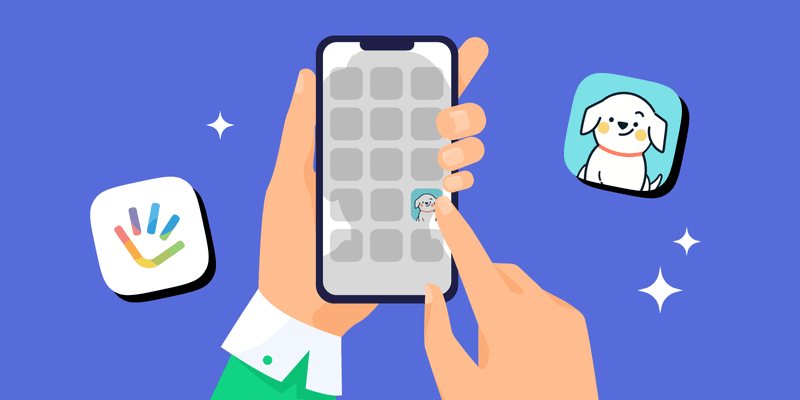Converting free users into paying subscribers is the biggest challenge for subscription apps. Many teams focus on UI refinements, feature showcases, and A/B testing paywalls, but conversion isn’t just about better design – it’s about helping users see their future selves with your product.
ASL Bloom, an app designed to help people learn sign language, faced this challenge. Despite offering high-quality educational content, users were dropping off at the paywall.
By rethinking onboarding through a psychological and goal-oriented lens, Applica helped ASL Bloom achieve a 15% increase in trial conversion rates and a 12% uplift in ARPU.
Read on for the details…
The real conversion gap: users couldn’t see their future selves
Like many subscription apps, ASL Bloom initially relied on feature-driven onboarding – showcasing the app’s capabilities upfront. But Mixpanel data told a different story. Users engaged with features in the free experience, yet many abandoned the journey when asked to subscribe.
Why?
Users were engaging with the app but were not converting because they couldn’t see how it would help them achieve what really mattered.
We hypothesised that there was a gap between feature presentation and user motivation. We knew ASL Bloom had all the right functionality, but the value wasn’t landing.
A research framework that starts with behavioural psychology
To tackle these issues, we utilised the Double Diamond framework which provided a structured process for creating a user-centric solution.

Step 1: Spotting where users were dropping off
We started by digging into the data with Mixpanel. One thing stood out: a big drop-off at the paywall during onboarding. Users were exploring the app, but not enough of them were making the leap to start a trial.
That told us something important, users weren’t seeing enough value early on. The features were there, but the connection to their personal goals wasn’t.
So we made a hypothesis: if we reworked the onboarding flow to focus on what users actually wanted to achieve, like having real conversations in sign language, we could make the experience more relevant, and that should lift conversions.
Step 2: Understanding what users were trying to achieve
The original onboarding flow dropped users straight into a lesson, the idea being that once they tried the product, they’d see its value. However, a different story emerged when we looked at things through a Jobs-to-Be-Done (JTBD) lens.
It wasn’t that users disliked the lesson itself. Through user interviews, we uncovered a few key motivations that weren’t being addressed:
- They wanted to learn from people who lived it – Users were not just looking for polished content.
- They wanted guidance from qualified Deaf educators who brought authenticity and lived experience. That trust factor was missing in the early journey.
- The real driver wasn’t finishing a course or trying a demo. It was being able to hold a conversation with someone they cared about – a Deaf friend, family member or colleague.
Trying a lesson on day one gave users a taste of the app but it didn’t help them picture the outcome they were working toward. That was the missing piece and it gave us a clear direction for change.
Step 3: Prioritising features that connect to user goals
To determine which features resonated most with users’ aspirations, we conducted a MaxDiff survey. The results showed that users placed the highest value on:
- Sign bank/dictionary
- Practice mode
- Slow-down function for sign playback
Rather than simply highlighting these as “top features,” we used them as anchors for storytelling – demonstrating how each one helped users make real progress.
For example, many interviewees wanted assurances that lessons are taught by qualified individuals (preferably Deaf educators) and that cultural nuances were accurately represented so the copy we used reflected this.
Implementing a user-centric onboarding experience
Following these insights, we redesigned onboarding to build trust, link features to aspirations, and position premium as a pathway to success.
1. Building trust through social proof
Social proof only existed on the paywall via testimonials in the old flow, so we created a few screens that focused on this from both perspectives (teachers and students).

2. Messaging that connects features to aspirations
Rather than listing features, we introduced onboarding screens to emphasise the benefits and impact of using ASL Bloom based on aspirations.

3. Building value before asking for a commitment
The new onboarding focused on helping users see the value early on instead of jumping straight to the paywall.
- Expert-led learning – Introducing users to a team of native Deaf educators added credibility and built trust.
- Personalised goals – Asking what users wanted to learn helped tailor the experience and made it feel more relevant.
- Achievable outcomes – Setting clear expectations (like learning 400 signs in 15 minutes a day) made progress feel doable.
By the time users reached the paywall, the app had already answered the question: “Is this worth it for me?”

4. A paywall that reinforces user goals
Instead of a generic pricing screen, we reframed the paywall as a bridge to achieving user goals.
- Goal-based framing: “This is what you achieve with ASL Bloom premium”
We also broke the paywall into two screens to simplify the decision-making process. The first screen reinforced the app’s value, and the second focused on the trial timeline to reduce friction in committing to a subscription.

The results: uplifts in key business metrics
- 15% increase in trial conversion rates
- 12% uplift in ARPU
- 28% increase in users who completed their first real-world communication goal
- 18% higher retention at the 30-day mark
Final thoughts: The psychology of successful onboarding
Onboarding and paywall optimisation are some of the most powerful levers for driving subscription growth, yet many apps focus too much on features instead of value.
If you’re looking to improve your onboarding flow, start by asking:
- What future state are users trying to achieve?
- How does each premium feature accelerate their progress?
- Is your paywall reinforcing user aspirations or acting as a barrier?
A structured approach can remove common roadblocks, like knowing where to start, how long optimisation should take, or how to iterate after launching an MVP.
The psychology-driven approach we used with ASL Bloom isn’t just theory – it’s something we’ve applied across multiple projects, consistently driving higher conversion rates, engagement, and revenue.
Effective onboarding begins with a deep understanding of your users and a clear link between product value and personal motivation.

